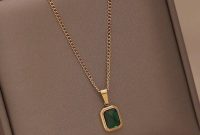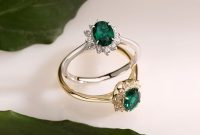Why Emeralds Are a Symbol of Royalty and Power
 Emeralds, with their rich green hue and captivating luster, have been revered throughout history as emblems of opulence, wisdom, and sovereignty. Across ancient civilizations and royal dynasties, these gems were not merely ornamental; they carried deep spiritual and political meaning. The emerald’s symbolism is rooted in millennia of mythology, conquest, and culture, making it a stone intimately linked with royalty and power.
Emeralds, with their rich green hue and captivating luster, have been revered throughout history as emblems of opulence, wisdom, and sovereignty. Across ancient civilizations and royal dynasties, these gems were not merely ornamental; they carried deep spiritual and political meaning. The emerald’s symbolism is rooted in millennia of mythology, conquest, and culture, making it a stone intimately linked with royalty and power.
In this article, we’ll explore how emeralds came to represent majesty, why they were favored by kings, queens, and emperors, and what their legacy means in the modern era. From Cleopatra’s treasury to the crowns of European monarchs, emeralds have long served as visual and symbolic affirmations of authority and divine right.
Ancient Civilizations and the Origins of Emerald Reverence The origins of emerald’s connection with power stretch back to some of the earliest advanced civilizations. In Ancient Egypt, emeralds were mined as early as 1500 BCE, with Cleopatra being the most famous royal devotee. Known for her extravagant tastes and strategic use of imagery, Cleopatra adorned herself with emeralds not just for beauty, but to project divine association. She believed the stone had regenerative and protective powers and often gifted emeralds to foreign dignitaries as a political statement.
To the Egyptians, green was a sacred color symbolizing fertility, rebirth, and eternal youth. Emeralds, with their verdant hue, were thought to bring life force and wisdom from the gods. They were buried with the dead to ensure safe passage to the afterlife, used in talismans, and placed in tombs to symbolize resurrection and eternal sovereignty.
In Ancient India, emeralds were also revered for their metaphysical properties. Sanskrit texts referred to them as “marakata,” meaning “the green of growing things.” Indian royalty wore emeralds for both spiritual guidance and physical protection, believing the gem had the power to enhance intellect and bring good fortune in governance.
These early associations with divine guidance, immortality, and royal privilege laid the foundation for emerald’s symbolic power in centuries to come.
The Inca and the Sacred Stone of the Andes In South America, the indigenous Muzo people of Colombia considered emeralds to be sacred long before the arrival of European colonizers. To the Incas and other Andean cultures, emeralds were gifts from the gods. These gems were not used as currency or for mundane purposes; rather, they were part of elaborate rituals, religious offerings, and elite regalia.
The Spanish conquest in the 16th century brought these emeralds into European markets, where their size and clarity stunned the Old World’s aristocracy. Legends of mountains filled with green gems added to the emerald’s allure, and the gems seized from the Inca temples quickly found their way into the treasuries of Spain, France, and England. This colonial plundering, while ethically troubling, significantly enhanced the status of emeralds as symbols of global conquest, wealth, and imperial dominance.
Thus, emeralds became part of a larger narrative—not just symbols of power, but spoils of empire, tying their possession to dominion over both people and nature.
Emeralds in European Royal Courts In Europe, emeralds became deeply woven into the fabric of monarchy and aristocracy. From the Renaissance onward, European royalty sought the largest, clearest, and most vivid emeralds to display in crowns, scepters, necklaces, and ceremonial garments. These jewels were far more than decorative; they conveyed divine authority, stability, and continuity of power.
In the courts of Spain and Austria, emeralds featured heavily in royal jewels, particularly during the 16th and 17th centuries. Spanish monarchs, flush with New World treasure, commissioned elaborate emerald-studded regalia to underscore their wealth and power. The Habsburg dynasty, too, was known for its affinity for emeralds, which were often incorporated into ornate religious artifacts and state jewelry.
The British royal family also held emeralds in high esteem. Queen Victoria famously received an emerald tiara from Prince Albert, a piece that would become a cherished part of the royal collection. Emeralds adorned coronation robes and were featured in royal portraiture to emphasize virtue, poise, and divine favor.
These choices were not arbitrary. In a time when monarchy was justified through religion and bloodline, emeralds provided visual reinforcement of a ruler’s God-given right to lead. Their rarity and radiant color made them ideal for conveying exclusivity and elevated status.
Symbolism of Green: Fertility, Wealth, and Eternal Life Color has always played a powerful role in symbolism, and green is no exception. Across cultures, green represents fertility, renewal, prosperity, and growth. It is the color of spring, life, and nature’s abundance—fitting qualities for a ruler who is seen as the lifeblood of a nation.
Emeralds, as the most precious of green gemstones, were therefore seen not only as emblems of wealth but also as talismans for prosperity and longevity. In times of political upheaval or uncertainty, a ruler adorned in emeralds appeared stable, fertile, and divinely favored. Their association with Venus—the Roman goddess of love and fertility—further enhanced emeralds’ appeal as symbols of fruitful leadership and harmonious rule.
Emeralds also came to symbolize clarity of mind and vision. This symbolism fit well within the narrative of the “philosopher-king,” an ideal leader guided by wisdom and higher understanding. Wearing emeralds subtly suggested that the ruler had not only political power but also divine wisdom and moral clarity.
Mystical and Astrological Associations Emerald’s spiritual symbolism further elevated its role among royals and power holders. In the Middle Ages, emeralds were believed to reveal truth, protect against evil spells, and even allow the wearer to see the future. Monarchs and nobles often carried emeralds as protective amulets, using them in courtrooms and councils to discern honesty and make fair judgments.
In astrology, emerald is linked with the planet Mercury, which governs communication, intellect, and commerce. It was believed to strengthen eloquence, improve memory, and enhance diplomatic negotiation—skills essential for effective leadership. Court astrologers and advisors often recommended emeralds for rulers engaged in treaties, trade agreements, or political alliances.
Mystics also believed that emeralds could calm emotional storms and encourage rational decision-making—qualities prized in any sovereign. This reputation made emeralds especially popular among philosopher-rulers, scholars, and enlightened monarchs who saw leadership as a spiritual duty, not just a political role.
Emeralds in Religious and Ceremonial Use In many traditions, emeralds were used in religious contexts to symbolize divine authority and spiritual leadership. The Catholic Church, for example, adorned miters, chalices, and altars with emeralds, reflecting the connection between heaven and earthly power. Bishops and popes wore emerald rings as a sign of spiritual jurisdiction and heavenly wisdom.
Islamic history also holds examples of emerald reverence. Emeralds were engraved with Quranic verses and worn by caliphs or used to decorate sacred texts. Their serene green color, echoing paradise as described in the Quran, made them ideal symbols of divine grace and enlightened rulership.
In Buddhist and Hindu traditions, emeralds were associated with compassion, the heart chakra, and divine knowledge. Kings and gurus alike wore them to deepen spiritual insight and promote balance between worldly and spiritual responsibilities.
This religious dimension added yet another layer of meaning, positioning emeralds not just as royal adornments, but as sacred stones that linked rulers to divine realms and higher responsibilities.
Famous Royal Emeralds Through the Ages Several historic emeralds have become legendary due to their beauty, size, or association with powerful figures. The Mogul Emerald, a massive gem weighing over 200 carats, was inscribed with Islamic prayers and dates back to the 17th century. Likely owned by a Mughal emperor, it represents the intersection of religious devotion and imperial power.
Another iconic example is the Crown of the Andes, a Spanish colonial relic encrusted with hundreds of emeralds, including a central stone believed to have belonged to Atahualpa, the last Inca emperor. The crown embodies the fusion—and the violence—of conquest, religion, and monarchy.
Modern examples include the Cambridge and Delhi Durbar Parure, a collection of emerald jewels worn by British royalty during state ceremonies and coronations. These pieces continue to project elegance, tradition, and enduring influence.
Each of these stones tells a story—not only of wealth, but of power dynamics, empire, and the symbolism that has surrounded emeralds for centuries.
Contemporary Symbolism and Continued Prestige In today’s world, emeralds still carry connotations of royalty, luxury, and power, though the context has evolved. Modern royalty and celebrities wear emeralds to signal sophistication, confidence, and individuality. From red carpet events to state banquets, emeralds remain an enduring symbol of high status and timeless elegance.
Luxury brands often feature emeralds in exclusive collections, promoting them as symbols of legacy and refinement. Their appeal now transcends monarchy and is often associated with self-empowerment, personal success, and inner wisdom. Yet the historical weight of emeralds still lingers—those who wear them are seen as commanding attention, radiating authority, and aligning themselves with the lineage of rulers past.
Moreover, emeralds have found their way into popular culture and media as icons of power. In fantasy literature and cinema, green gems often represent enchanted artifacts or royal lineage, further embedding the emerald into our collective imagination as a gem of prestige and destiny.
Final Thoughts Emeralds have earned their place in the pantheon of powerful symbols—not merely because of their rarity or beauty, but because of the immense cultural, spiritual, and political weight they carry. From ancient pharaohs and Incan priests to Renaissance monarchs and modern royalty, emeralds have served as constant companions to power.
They are not just adornments but affirmations: of legitimacy, of divine favor, of mastery over self and society. Their deep green light speaks of life and authority, of wisdom born from experience, and of leadership grounded in both heart and mind.
To wear or work with emerald is to connect with a timeless legacy—a legacy where vision, love, sovereignty, and strength converge in one luminous stone.




